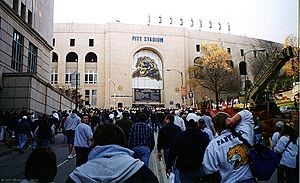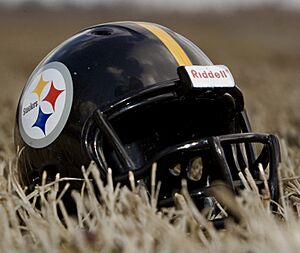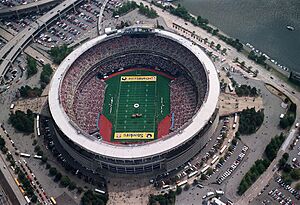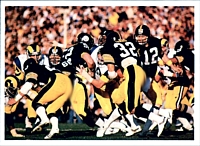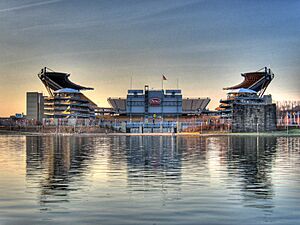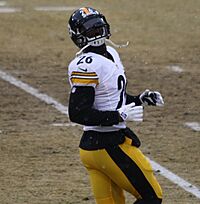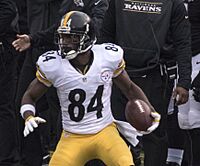History of the Pittsburgh Steelers facts for kids
The Pittsburgh Steelers are a professional American football team from Pittsburgh, Pennsylvania. They are one of the oldest teams in the National Football League (NFL), joining in 1933. Only a few teams have been around longer, like the Chicago Bears and Green Bay Packers.
The team was started by Arthur J. "Art" Rooney. His family has owned the team for almost its entire history. The Steelers have won six Super Bowl championships, which is a lot! They were the first NFL team to win six Super Bowls in 2008. Many Steelers players and coaches have become famous and are in the Pro Football Hall of Fame.
Contents
- How the Steelers Started
- The Early Years: Tough Times
- The 1970s: The Steel Curtain Dynasty
- The 1980s and 1990s: New Eras
- Bill Cowher's Years (1992-2006)
- Mike Tomlin's Years (2007-Present)
- Division Winners (2007)
- Sixth Super Bowl Win (2008)
- Missing Playoffs (2009)
- Super Bowl Loss (2010)
- Upset in Playoffs (2011)
- 80th Season (2012)
- The "Killer B's" Emerge (2013)
- Return to Playoffs (2014)
- Wild Card Berth (2015)
- AFC Championship Game (2016)
- Dominant Season, Early Exit (2017)
- Team Troubles (2018)
- Roethlisberger's Injury (2019)
- Strong Start, Tough Finish (2020)
- Big Ben's Final Season (2021)
- New Quarterbacks (2022)
- Steelers' Impact on Pittsburgh
- Steelers Rivalries
How the Steelers Started
Art Rooney, who grew up in Pittsburgh, was an amazing athlete. He was good at football, baseball, and even boxing! His love for sports led him to create his own semi-professional football team when he was a teenager. He called it the Hope-Harvey Football Club.
The Hope-Harvey team played against other local teams. Fans would donate money, which was then shared among the players. Art Rooney sometimes played quarterback for his team, and his younger brothers also played. These teams were quite successful, winning local championships in the early 1930s.
These early teams, which later changed names to Majestic Radio and James P. Rooneys, played most of their games at Exposition Park in Pittsburgh. Many players came from local colleges like Pitt and Duquesne.
At that time, Pittsburgh didn't have a fully professional football team. This was because of "blue laws" in Pennsylvania, which stopped sports on Sundays. Most NFL games were played on Sundays to avoid clashing with college games on Saturdays.
The Early Years: Tough Times
In May 1933, when Pennsylvania's blue laws were expected to change, Art Rooney asked to join the NFL. His request was approved, and the Pittsburgh Professional Football Club, Inc. became part of the league. The team was first called the Pirates because they shared a stadium, Forbes Field, with the baseball team.
For many years, the Pirates struggled. Between 1933 and 1971, they only had a winning record eight times. They made the playoffs just once, in 1947, but lost that game.
The Pirates Era (1930s)
In the early days, the Pirates weren't Art Rooney's only focus. He also loved horse racing and his winnings sometimes helped keep the football team going. It was hard for new teams like the Pirates to compete with older, richer teams for players. In 1935, Rooney suggested ideas that led to the NFL Draft, which started in 1936. This helped spread talented players more fairly among all teams.
The Pirates' first uniforms were gold with black stripes, inspired by Pittsburgh's city flag. Their very first game was a 23–2 loss to the New York Giants. Their first win came a week later, 14–13 against the Chicago Cardinals.
The team finished its first season with a 3–6–2 record. Over the years, Rooney tried to hire famous coaches like Red Grange, but they often chose college jobs instead. In 1938, the team signed Byron "Whizzer" White, a superstar player, for a huge salary. White led the league in rushing, but the team still only won two games. White later became a U.S. Supreme Court Justice!
The 1939 season was even worse, with a 1–9–1 record. Through the 1930s, the Pirates never had a winning record.
A New Name and a Big Swap (1940-1941)
In 1940, Rooney decided the team needed a new name. A contest was held, and the name Steelers was chosen. This name honored Pittsburgh's main industry: steel production.
In December 1940, Rooney sold the Steelers to Alexis Thompson. Rooney then bought half-ownership of the Philadelphia Eagles with his friend, Bert Bell. In a very unusual move, the Steelers and Eagles essentially swapped teams! Rooney and Bell's Eagles moved to Pittsburgh and became the Steelers, while Thompson's team moved to Philadelphia and became the Eagles. This strange event was called the "Pennsylvania Polka." Because the team never actually left Pittsburgh, the NFL considers Art Rooney's ownership unbroken.
The War Years (1941-1944)
During World War II, many NFL players joined the military. This made it hard for teams to find enough players. The Steelers picked "Bullet" Bill Dudley first in the 1942 draft. He was a great player and led the league in rushing, helping the Steelers have their first winning record (7–4) in 1942.
The Steagles
In 1943, due to the war, the Steelers and the Eagles combined their teams for one season. This merged team was unofficially called the "Steagles". They split their home games between Pittsburgh and Philadelphia. The coaches, Greasy Neale and Walt Kiesling, didn't get along, so they split duties: one coached offense, the other defense. The Steagles finished with a winning record (5–4–1), which was a big improvement for both teams. After the season, they split back into separate teams.
Card-Pitt
In 1944, the Steelers merged again, this time with the Chicago Cardinals. This team was called "Card-Pitt" and was sometimes joked about as the "Carpets" because they went winless (0–10). The Steelers went back to being a solo team in 1945.
The "Same Old Steelers" (1940s-1960s)
The Steelers made the playoffs for the first time in 1947, but lost to the Philadelphia Eagles. This was their only playoff game for 25 years. The phrase "Same Old Steelers" became a common saying among fans because the team often struggled.
A famous story from this era is about Johnny Unitas. The Steelers drafted him in 1955 but cut him during training camp. Unitas went on to become a Super Bowl hero with the Baltimore Colts, which was a tough miss for Pittsburgh fans!
In 1957, Lowell Perry became the NFL's first African American coach, joining the Steelers as a receivers coach. In 1958, the Steelers finally had a winning record (7–4–1) after nine years, thanks to quarterback Bobby Layne. They also started playing some home games at Pitt Stadium.
The 1960s
In 1962, the Steelers introduced their famous "astroid" logo, which is still used today. It's based on the Steelmark logo of the US steel industry. That year, they had their best season yet, finishing 9–5.
However, the team struggled again for the rest of the 1960s. They often missed out on talented local quarterbacks like Joe Namath and Joe Montana, who became stars for other teams. This was a frustrating time for Steelers fans.
The 1970s: The Steel Curtain Dynasty
The Steelers' luck changed when they hired coach Chuck Noll in 1969. Even though they only won one game in his first season, it was the start of something big.
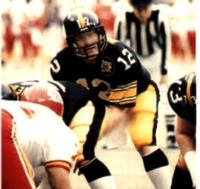
In 1970, the Steelers won a coin toss against the Chicago Bears, which gave them the first pick in the NFL Draft. They chose superstar quarterback Terry Bradshaw. This was a huge moment!
Chuck Noll was amazing at drafting players. He picked future Hall of Famers like "Mean" Joe Greene (1969), Mel Blount (1970), Jack Ham (1971), Franco Harris (1972), and Mike Webster, Lynn Swann, John Stallworth, and Jack Lambert (all in 1974). This group of players became the core of one of the greatest teams in NFL history.
In 1970, the Steelers moved into Three Rivers Stadium. They also joined the new American Football Conference (AFC) after the AFL–NFL merger. This brought them a lot of money, which helped them build a winning team.
The Immaculate Reception (1972)
The 1972 season was a breakthrough. Rookie Franco Harris ran for over 1,000 yards. The Steelers finished 11–3 and made the playoffs for the first time in 25 years.

Their first playoff game against the Oakland Raiders featured one of the most famous plays ever: the Immaculate Reception. With seconds left and the Steelers losing, Terry Bradshaw threw a pass that was deflected. Franco Harris miraculously caught the ball before it hit the ground and ran for the winning touchdown! This play launched the Steelers into their glory years. They lost the next game to the undefeated Miami Dolphins, but it was a sign of great things to come.
First Two Super Bowls (1974-1975)
1974: Super Bowl IX
The Steelers' defense, known as the "Steel Curtain", became incredibly strong. In 1974, they reached Super Bowl IX against the Minnesota Vikings. It was a tough defensive game, but the Steelers won 16–6, earning their first championship after 42 years!
1975: Super Bowl X
The 1975 season was even better. The Steelers went 12–2. They faced the Dallas Cowboys in Super Bowl X. The Steelers won a thrilling game 21–17. Lynn Swann was named the game's MVP for his amazing catches.
Playoff Losses (1976-1977)
In 1976, the Steelers started slow but won their last nine games, with their defense being incredibly dominant. They lost in the AFC Championship to the Oakland Raiders. The 1977 season was a bit disappointing, but they still won their division before losing in the playoffs.
Third and Fourth Super Bowls (1978-1979)
1978: Super Bowl XIII
In 1978, the Steelers had a fantastic 14–2 record. They reached Super Bowl XIII for a rematch with the Cowboys. This game is considered one of the best Super Bowls ever. Terry Bradshaw threw four touchdowns, and the Steelers won 35–31. Bradshaw was named game MVP.
1979: Super Bowl XIV
The 1979 season was the last of this amazing dynasty. The Steelers finished 12–4 and reached their fourth Super Bowl against the Los Angeles Rams. Even though the Rams knew some of the Steelers' plays, Pittsburgh won 31–19.
The Steelers' success in the 1970s made them famous across the country. Their loyal fans are known as Steeler Nation, and they wave the terrible towel (a bright yellow cloth) during games.
The 1980s and 1990s: New Eras
Many of the great players from the 1970s retired in the 1980s. The team was still competitive for a while but then struggled.
Missing the Playoffs (1980-1981)
The Steelers missed the playoffs in 1980 and 1981, marking the end of their dynasty.
Playoff Exits (1982-1984)
In 1982, the Steelers made the playoffs but lost to the San Diego Chargers. Terry Bradshaw played his last season in 1983 due to an elbow injury. The Steelers won their division but lost in the playoffs to the Los Angeles Raiders. In 1984, they surprised everyone by winning their division again, but lost the AFC Championship to Dan Marino and the Miami Dolphins.
Tough Times (1985-1988)
The Steelers had losing seasons from 1985 to 1988. In 1988, the team's founder, Art Rooney, passed away.
Playoff Returns (1989-1991)
In 1989, the Steelers had a rough start but finished 9–7 and made the playoffs. They won a thrilling overtime game against the Houston Oilers but then lost to John Elway and the Denver Broncos. The 1990 season saw the Steelers with the No. 1 defense, but they missed the playoffs. In 1991, rookie quarterback Neil O'Donnell showed promise, but the team finished 7–9.
Bill Cowher's Years (1992-2006)
Chuck Noll retired in 1991 and was replaced by Bill Cowher, a Pittsburgh native. Cowher led the Steelers to the playoffs in each of his first six seasons, which was a huge achievement.
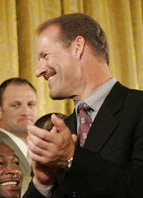
Early Playoff Losses (1992-1994)
In 1992, the Steelers went 11–5 and won their division, but lost in the playoffs to the Buffalo Bills. In 1993, they lost a close overtime playoff game to the Kansas City Chiefs. In 1994, the "Steel Curtain" defense was strong again, and the Steelers had a 12–4 record. They were favored to win the AFC Championship but lost a surprising game to the San Diego Chargers.
Super Bowl XXX Loss (1995)
In 1995, the Steelers had another great season (11–5) and reached Super Bowl XXX against the Dallas Cowboys. Despite a comeback attempt, the Steelers lost 27–17. Quarterback Neil O'Donnell threw three interceptions, which hurt their chances.
More Playoff Appearances (1996-1997)
After O'Donnell left, Kordell Stewart became the starting quarterback in 1997. Running back Jerome Bettis joined the team and quickly became a fan favorite. The Steelers won their division in both 1996 and 1997. In 1997, they reached the AFC Championship again but lost to the Denver Broncos.
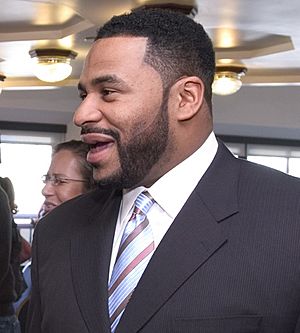
Struggles and a Famous Coin Flip (1998-1999)
The Steelers missed the playoffs in 1998 and 1999. The 1998 season included a famous Thanksgiving game against the Detroit Lions where a coin flip call before overtime caused a lot of controversy. The Steelers lost that game and missed the playoffs.
Back to Winning (2000-2002)
In 2000, the Steelers played their last season at Three Rivers Stadium. They finished 9–7 but missed the playoffs.
In 2001, the Steelers opened Heinz Field. They had a great 13–3 record and reached the AFC Championship, but lost to the New England Patriots. In 2002, Tommy Maddox became the starting quarterback, leading the team to a 10–5–1 record. They won a wild comeback game against the Cleveland Browns in the playoffs but lost a dramatic overtime game to the Tennessee Titans.
A Down Year (2003)
The 2003 season was disappointing, with the team finishing 6–10.
Ben Roethlisberger's Amazing Rookie Season (2004)
In the 2004 draft, the Steelers picked quarterback Ben Roethlisberger. He became the starter early in the season and led the team to an incredible 15–1 record, setting a record for most wins by a rookie quarterback. The team's strong running game with Jerome Bettis and tough defense made them one of the best teams in the NFL.
The Steelers won their first playoff game against the New York Jets in overtime. However, they lost the AFC Championship at home to the New England Patriots.
Fifth Super Bowl Win (2005)

In 2005, Willie Parker became the starting running back due to injuries. The Steelers had a tough season but won their last four games to make the playoffs as the last seed. They then went on an amazing road trip through the playoffs.
They defeated the Cincinnati Bengals, then upset the No. 1 seeded Indianapolis Colts in a thrilling game where Ben Roethlisberger made a game-saving tackle. Then, they won the AFC Championship against the Denver Broncos.
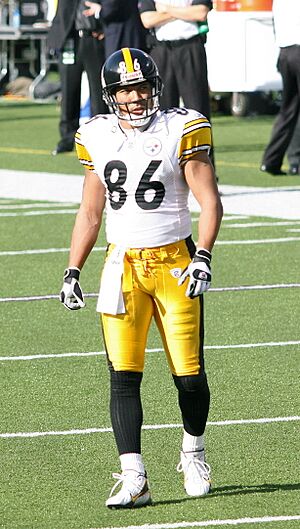
On February 5, 2006, the Steelers defeated the Seattle Seahawks 21–10 in Super Bowl XL. This was a special win for Detroit native Jerome Bettis, who retired after the game. The Steelers became the first sixth-seeded team to win the Super Bowl. Roethlisberger became the youngest quarterback to win a Super Bowl. They tied the record for most Super Bowl titles with five.
No Playoffs (2006)
The Steelers finished the 2006 season with an 8–8 record and missed the playoffs.
Mike Tomlin's Years (2007-Present)
Division Winners (2007)
In 2007, the Steelers improved to a 10–6 record and won the AFC North Division. Six Steelers players were chosen for the Pro Bowl.
Sixth Super Bowl Win (2008)

In 2008, James Harrison had an incredible season, winning Defensive Player of the Year. Troy Polamalu also had many interceptions. The Steelers finished 12–4 and earned a first-round bye in the playoffs. They beat the San Diego Chargers and their rivals, the Baltimore Ravens, to reach their seventh Super Bowl.
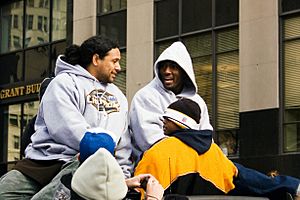
Super Bowl XLIII was played on February 1, 2009, against the Arizona Cardinals. The Steelers were ahead at halftime. The Cardinals made a comeback, but Santonio Holmes scored a touchdown in the final two minutes, giving the Steelers a 27–23 win. This made the Steelers the first team to win six Super Bowls!
Missing Playoffs (2009)
The defending champions started well in 2009 but lost five games in a row, partly due to injuries to key players like Troy Polamalu. They finished 9–7 and missed the playoffs.
Super Bowl Loss (2010)
In 2010, the Steelers had a strong season, finishing 12–4 and winning the AFC North. They beat the Baltimore Ravens and New York Jets in the playoffs to reach Super Bowl XLV. They faced the Green Bay Packers in the Super Bowl and lost a close game 31–25.
Upset in Playoffs (2011)
The Steelers finished 12–4 in 2011 but were upset by the 8–8 Denver Broncos in the first round of the playoffs. The Broncos won in overtime on the very first play.
80th Season (2012)
In their 80th season, the Steelers finished 8–8 and missed the playoffs. This was their first non-winning season since 2006.
The "Killer B's" Emerge (2013)
The Steelers started 0–4 in 2013, their worst start since 1968. However, rookie running back Le'Veon Bell had a great season. Bell, along with receiver Antonio Brown and quarterback Ben Roethlisberger, formed a powerful offensive trio known as the "Killer B's." The team finished 8–8 and missed the playoffs again.
Return to Playoffs (2014)
In 2014, the Steelers improved to 11–5 and returned to the playoffs. The "Killer B's" were dominant, with Roethlisberger, Bell, and Brown all having amazing seasons. However, they lost to the Baltimore Ravens in the Wild Card round.
Wild Card Berth (2015)
The Steelers finished 10–6 in 2015 and made the playoffs as a Wild Card team. They beat the Cincinnati Bengals in a very intense game. However, they lost to the Denver Broncos in the next round.
AFC Championship Game (2016)
In 2016, the Steelers won their division and made the playoffs for the third straight year. Le'Veon Bell made his first playoff appearance. They defeated the Miami Dolphins and Kansas City Chiefs before losing to the New England Patriots in the AFC Championship Game.
Dominant Season, Early Exit (2017)
The Steelers had a dominant 13–3 record in 2017. They signed Antonio Brown to a big contract and drafted talented players like T. J. Watt and JuJu Smith-Schuster. Despite their great record, they were upset in the Divisional round of the playoffs by the Jacksonville Jaguars.
Team Troubles (2018)
The "Killer B's" era started to end in 2018. Le'Veon Bell held out and didn't play all season. Antonio Brown had many conflicts with the team and was later traded. Even Ben Roethlisberger was criticized. The team finished 9–6–1 and missed the playoffs.
Roethlisberger's Injury (2019)
In 2019, Ben Roethlisberger suffered a season-ending elbow injury early in the year. Rookie Mason Rudolph and Devlin Hodges took over at quarterback. The defense was much improved, but the offense struggled without their star players. The Steelers finished 8–8 and missed the playoffs again.
Strong Start, Tough Finish (2020)
Ben Roethlisberger returned in 2020, and the Steelers started with an amazing 11–0 record, their best start ever! They had big wins over rivals like the Cleveland Browns and Baltimore Ravens. However, they lost their last three regular-season games. They won their division but were upset by the Cleveland Browns in the first round of the playoffs, ending a promising season.
Big Ben's Final Season (2021)
In 2021, the Steelers made the playoffs with a 9–7–1 record but lost to the Kansas City Chiefs. After the season, Ben Roethlisberger retired, ending an 18-year career where he played only for the Steelers. He holds many team records and is one of the greatest quarterbacks in NFL history.
New Quarterbacks (2022)
After Roethlisberger retired, the Steelers signed Mitchell Trubisky and drafted Kenny Pickett to compete for quarterback. Pickett became the starter in Week 5 and connected well with rookie receiver George Pickens. Despite a slow start, the Steelers finished 9–8, continuing their streak of non-losing seasons, but narrowly missed the playoffs.
Steelers' Impact on Pittsburgh
The Pittsburgh Steelers have had a huge impact on the city of Pittsburgh. They bring millions of dollars to the area through ticket sales and merchandise, helping the local economy.
The Steelers also do a lot of community service. Their foundation supports many charities, and players often help with community projects. The team has helped shape Pittsburgh's identity and given generations of fans a sense of pride and belonging.
Steelers Rivalries
The Steelers have strong rivalries with their division opponents: the Cleveland Browns, Baltimore Ravens, and Cincinnati Bengals. They have a winning record against all three.
- Cleveland Browns: These two teams have been in the same division for a long time and play at least twice a year.
- Las Vegas Raiders: The Steelers and Raiders had many intense playoff games in the 1970s.
- Dallas Cowboys: The Steelers and Cowboys have played each other in three Super Bowls, with Pittsburgh winning two of them. Both teams were known for their strong defenses in the 1970s.
- Denver Broncos: The Steelers and Broncos have played eight times in the playoffs.
- New England Patriots: This rivalry has become very intense in recent years, with many close games and important playoff matchups.




